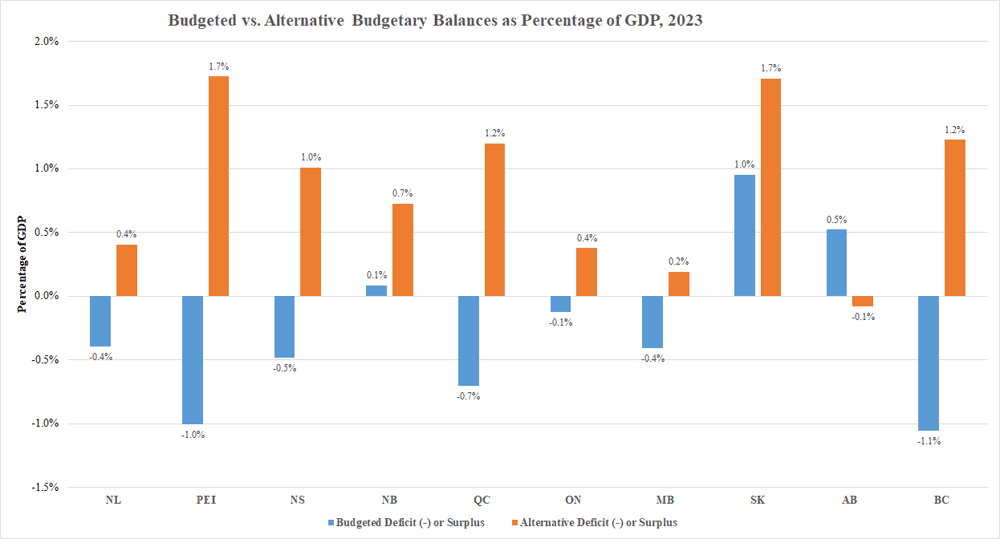Provinces would be running surpluses if they showed spending restraint

In the most recent round of budgets, seven out of 10 provinces projected deficits for the 2023-24 fiscal year. However, the provinces could be in a much better fiscal position if they had shown fiscal restraint and returned to pre-pandemic (2019-20) levels of per-person (inflation-adjusted) program spending.
Government debt has been rising for a long time in Canada. Since 2007-08, combined federal and provincial net debt (total debt minus financial assets), adjusted for inflation, has nearly doubled from $1.1 trillion to $2.1 trillion in 2022-23. Clearly there’s a growing debt problem, and this year the provinces had an opportunity to reverse this trend by exercising spending restraint. But again, most provinces elected to maintain elevated spending levels and incur budget deficits.
Accumulating debt of this magnitude has significant consequences for provincial governments. Higher debt (all else equal) means provinces must pay higher interest costs, which reduces the amount of revenue available for spending on programs such as education or health care. For example, Ontario is projected to spend more on debt interest ($14.1 billion) than on post-secondary education ($12.1 billion) in 2023-24. And growing government debt has been linked to reduced economic growth.
While government debt can be useful temporarily because it allows governments to maintain spending during periods of reduced revenues, it should not be accumulated indefinitely. By consuming a portion of the revenue available for programs such as health care and education, rising interest costs pressure governments to fund new and current programs through more debt, which subsequently increases the cost of borrowing and fuels a vicious cycle. This is why it’s important provinces look for opportunities to achieve budgetary surpluses that reduce accumulated debt and limit interest costs.
To examine the opportunity missed by the provinces, we compare current projected budget balances with those in an alternative scenario, which assumes that provinces returned 2023-24 program spending back to 2019-20 per-person inflation-adjusted levels. In other words, we assume program spending is at 2019/20 levels, but adjusted for population growth and the higher general prices. The chart below compares the current projected budgetary balances and the alternative budgetary balances as a percentage of the economy (as measured by GDP).
As shown, the difference is stark between the two scenarios. Had the provinces been more disciplined with spending, nine out of 10 provinces would project surpluses this year instead of the seven out of 10. As a percentage of GDP, Prince Edward Island (2.7 per cent), Quebec (1.9 per cent) and British Columbia (2.3 per cent) have the largest changes in their budgetary balances in the alternative scenario. In dollars, the difference is most significant in Quebec, Ontario and B.C., as Quebec goes from a $4.0 billion deficit to a $6.8 billion surplus, Ontario from a $1.3 billion deficit to a $4.1 billion surplus, and B.C.’s fortunes improve from a $4.2 billion deficit to a $4.9 billion surplus.
Adding up the budgetary balances shows that provinces go from a projected cumulative deficit of $7.0 billion in 2023-24 to a cumulative surplus of $18.7 billion in the alternative scenario. This means, with spending restraint, provinces could have avoided increasing debt collectively by $7.0 billion and instead reduced debt by $18.7 billion. Put differently, provinces would have been better off by a combined $25.7 billion in 2023-24 had they been more disciplined with spending. Surpluses could have been used to pay off debt and reduce provincial interest costs, and/or reduce the tax bill for families.
Following a long string of provincial deficits during the last 15 years, spending restraint in 2023-24 would have helped reverse that trend and start many provinces back towards more stable fiscal footing. Rather than maintain the elevated levels of spending seen over the last several years, provinces should spend more responsibly moving forward.
Authors:
Subscribe to the Fraser Institute
Get the latest news from the Fraser Institute on the latest research studies, news and events.


